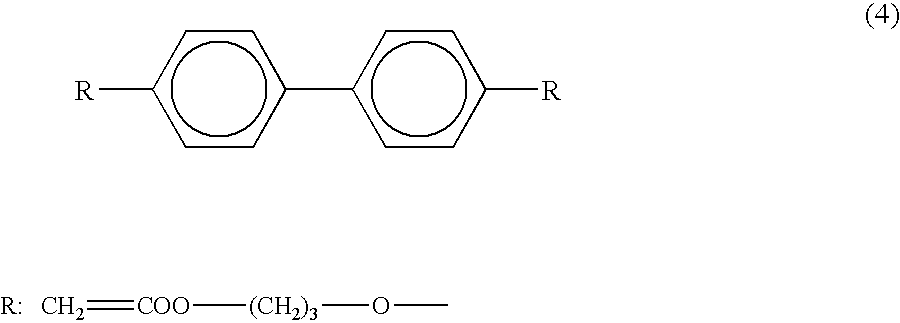Liquid crystal display with polymeric support
a technology of liquid crystal display and polymeric support, which is applied in the direction of liquid crystal compositions, instruments, chemistry apparatus and processes, etc., can solve the problems of low light transmittance, low contrast of display devices, and inability to find a wide range of use, so as to improve display quality, reduce the dependence of display contrast on a viewing angle, and optimize the light transmittance of display devices
- Summary
- Abstract
- Description
- Claims
- Application Information
AI Technical Summary
Benefits of technology
Problems solved by technology
Method used
Image
Examples
example 1
FIG. 1 is a cross-sectional view of a liquid crystal display device 1 in Example 1 according to the present invention. The liquid crystal display device 1 includes a pair of glass substrates 2 and 3 having a thickness of 1.1 mm each. On the glass substrate 2, a plurality of segmented electrodes 4 and a plurality of switching devices 5 are provided in a matrix. The segmented electrodes 4 are made of a mixture containing indium oxide and tin oxide (ITO), and have a thickness of 50 nm. The switching devices work for applying a signal voltage to the segmented electrodes 4, or for interrupting the signal voltage. As the switching devices, for example, a thin film transistor (TFT) is used. An organic thin film 6 covers the segmented electrodes 4 and the switching devices 5. It is noted that the organic thin film 6 can be omitted. Accordingly, a TFT substrate 12 is constructed.
On the other glass substrate 3, a counter electrode 7 made of ITO is provided. In addition, a black mask 8 having ...
example 2
Another example of the present invention will be described.
A cell was fabricated using a counter substrate having a color filter 10 as shown in FIG. 11 and a TFT substrate having a black mask 24 with light-transmitting portions 29 on its surface as shown in FIG. 12 so as to have a cell gap of 5.0 .mu.m.
The same mixture as that of Example 1 was injected into the cell thus fabricated, and the cell was irradiated using the color filter in the cell as a mask with UV-rays in the same way as in Example 1 so that the mixture was cured by self-alignment. The cell was observed with a polarizing microscope, indicating that each entire pixel was occupied with a mono-domain, and liquid crystal molecules were concentrically oriented in each domain.
Two crossed polarizing plates were attached to both sides of the cell thus fabricated to obtain a liquid crystal display device according to the present invention. The light transmittance of the cell under the application of no voltage is shown in Tabl...
examples 1 and 2
will be described based on Construction Examples 5 to 8 together with Comparative Examples 6 to 8.
In Construction Examples 5, 6, 7, and 8 and Comparative Examples 6, 7, and 8, cells were fabricated in the same way as in the above-mentioned examples, except that a cell gap between the two substrates 12 and 13 was set to be 4.8 .mu.m. As shown in Table 3, the twist angles of liquid crystal molecules in the liquid crystal region 17 were changed by varying the amount of chiral liquid crystal to be added to the liquid crystal material.
TABLE 3 Comparative Comparative Construction Construction Construction Construction Comparative example 6 example 7 example 5 example 6 example 7 example 8 example 8 Twist angle 0 30 60 90 120 150 180 (degree)
Liquid crystal display devices 1 were produced by using the same material and method for production as those in Construction Examples 1 to 4. Light transmittance of the liquid crystal display devices 1 was plotted with respect to a twist angle in FIG. ...
PUM
| Property | Measurement | Unit |
|---|---|---|
| viscosity | aaaaa | aaaaa |
| twist angle | aaaaa | aaaaa |
| transmittance | aaaaa | aaaaa |
Abstract
Description
Claims
Application Information
 Login to View More
Login to View More - R&D
- Intellectual Property
- Life Sciences
- Materials
- Tech Scout
- Unparalleled Data Quality
- Higher Quality Content
- 60% Fewer Hallucinations
Browse by: Latest US Patents, China's latest patents, Technical Efficacy Thesaurus, Application Domain, Technology Topic, Popular Technical Reports.
© 2025 PatSnap. All rights reserved.Legal|Privacy policy|Modern Slavery Act Transparency Statement|Sitemap|About US| Contact US: help@patsnap.com



